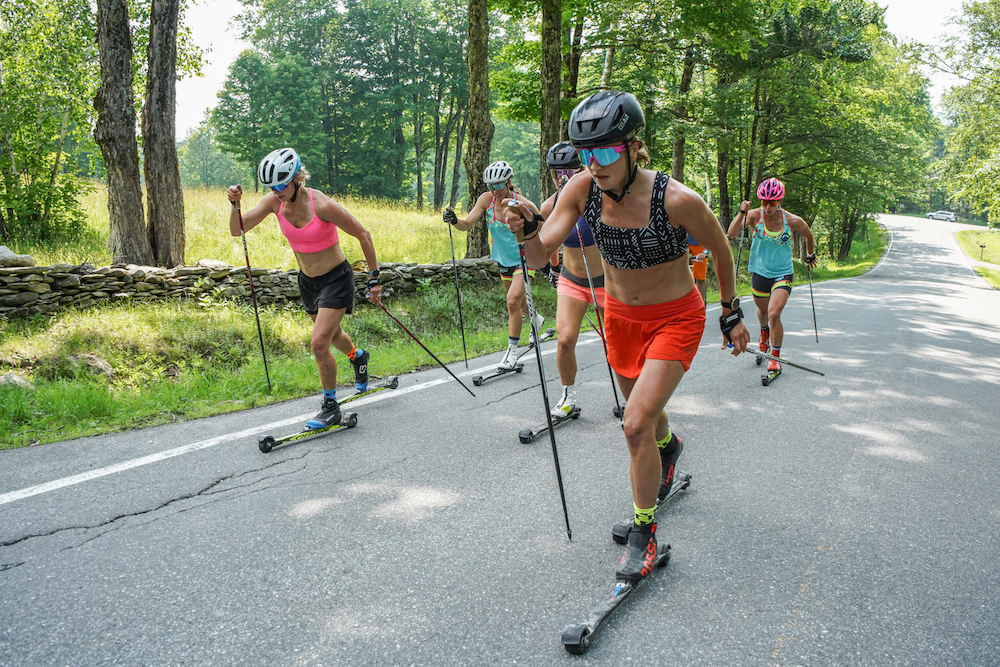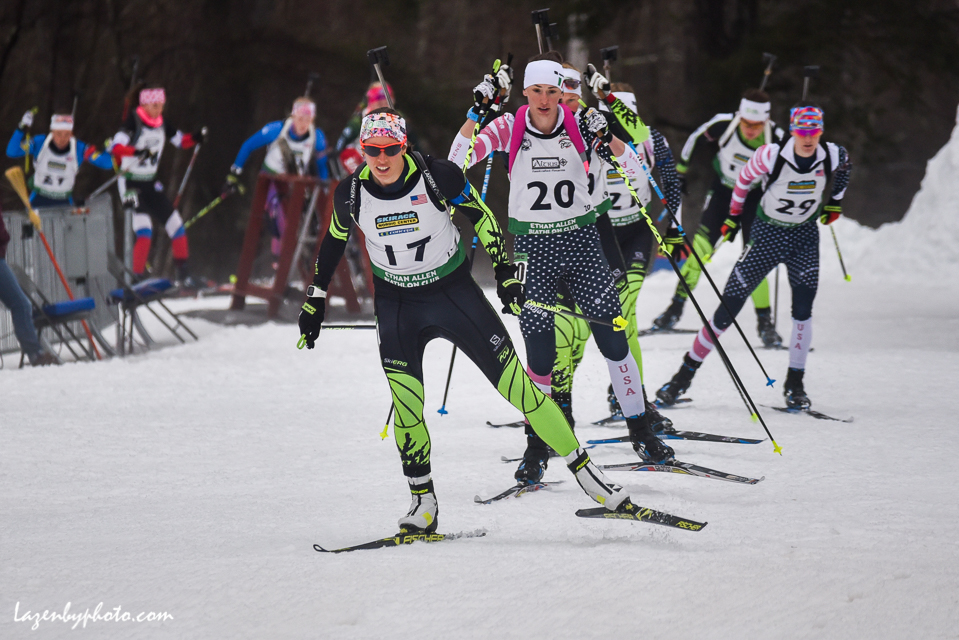
We tend to highlight World Cup races on this website, but those results, and those athletes, don’t happen in a vacuum. Skiers are made in the summer, as the well-worn saying accurately has it, and summer training means time spent with a domestic ski club. So we’re going to be highlighting the athletes on several prominent American ski clubs over the next few weeks, only a small portion of whom will be starting on the World Cup this fall.
If World Cup skiers are the pinnacle of a pyramid, then their club teammates are the indispensable supporting layer just beneath them. Go back and peruse one of Jessie Diggins’s multiple posts highlighting the importance of her team. Diggins doesn’t say, “I’d like to thank my teammates who ski with me on the World Cup, and only those teammates.” Diggins instead, of course, just says, “I’d like to thank my teammates.” There’s not much place for pedigree when you’re digging deep in bounding intervals in July, months and miles away from snow-covered European race courses.

This isn’t just an attempt to make club skiers feel good, either. Consider Caitlin Gregg’s World Championships bronze in 2015, Chelsea Holmes’s 13th in the 2017 World Championships 30km, Rosie Frankowski’s 21st in the 2018 Winter Olympics 30km. None of them was on the national team at the time of this breakthrough result; all of them were “just” club skiers. There are larger, complicated questions here about the interplay between the domestic race circuit and the World Cup when it takes so much time and money to travel between America and Europe, and World Cup–based skiers seldom race SuperTour-based skiers head-to-head, but it seems fair to say that some Americans racing at home are comparable to some Americans racing overseas.
(It also seems fair to say that the fact that Holmes was the third alternate on that memorable day, and got the start only after two U.S. Ski Team athletes, who were also her club teammates, turned it down, speaks to some of these larger questions.)
All that said, please enjoy our preview of six domestic ski clubs and their athletes, starting tomorrow and continuing over the next several weeks.

This is not the first time that FasterSkier has written such a preview, but it is the first time in a few years. And compared to prior installments in this series, the ecosystem of American skiing has become notably more homogenous, at the same time that American skiing has become more successful. Here are the six clubs that we will preview this fall:
- Alaska Pacific University Nordic Ski Center
- Bridger Ski Foundation
- Craftsbury Green Racing Project
- Stratton Mountain School
- Sun Valley Ski Education Foundation
- Team Birkie
And here are the twelve clubs featured in, for example, summer 2012 (links to the whole series are at the bottom of this article from November 2012, if you’d like to really go down memory lane for a bit):
- Alaska Pacific University Nordic Ski Center
- Bend Endurance Academy
- Bridger Ski Foundation
- Craftsbury Green Racing Project
- Central Cross Country (CXC)
- Far West Farm Team
- Maine Winter Sports Center
- Methow Olympic Development
- SMS T2 Team
- Ski and Snowboard Club Vail Team HomeGrown
- Sun Valley Ski Education Foundation (SVSEF) Gold Team
- XC Oregon
Twelve is, obviously, more than six; spare a thought for Bend Endurance Academy, Far West Farm Team, Maine Winter Sports Center, Methow Olympic Development, Team HomeGrown, and XC Oregon as high-level American club teams (and, sort of, CXC Elite, though Team Birkie is in many ways its spiritual heir, with Caitlin and Brian Gregg as the through line).

We’ll leave it to you to debate whether this is “good,” “bad,” or neutral – whether it is good that more high-level skiers are training in consort in larger groups; bad that fewer coaching ideas or philosophies may have the chance to be heard, and that athletes outside four regions of the country have to travel to find a team (those members of the U.S. Ski Team A-Team who originally hail from Utah, Colorado, California, or Minnesota, for example, which currently describes four-fifths of the A-Team, had to leave home to find a club team); or neutral because improved American results justify a homogenization of the domestic training landscape, regardless of what might have been lost along the way. Maybe some of all of the above.
But regardless of the merits of this shift, it’s worth noting that things change. At the turn of the century, the best ski program in Alaska was the college team at University of Alaska Anchorage. In summer 2010, an ascendant Diggins was the nucleus of a strong CXC team, alongside Caitlin Compton (now Gregg), Jennie Bender, Tad Elliott, Garrott Kuzzy, Brian Gregg, and Matt Liebsch. In fall 2012, this site wrote, surveying the prior season’s SuperTour racing, “Central Cross Country (CXC) was indisputably the best all-around team last year.” And it alluded to the potential of a new group forming at Stratton Mountain – which was at that point still just potential, because the team had officially formed only earlier that year. Indeed, this article, entitled, “With Elite Team, Stratton Aims To Create ‘Hotbed of Skiing’ in Southern Vermont,” was published in 2012. (Spoiler alert: this worked.)

Now we’re at a point where APU* or SMS frequently send six athletes each to a World Cup race or global championship, where there are currently eight national team athletes in one club alone (APU), and no current U.S. Ski Team members primarily based in the Midwest. No one knows what this list will look like in another decade, but for the time being, six clubs is decidedly fewer than twelve clubs.
Please enjoy the first preview, coming tomorrow.
* Disclaimer: I live in Anchorage, and have trained with the APUNSC Masters program for eight seasons and counting. On the one hand, the Masters group has been an important part of my personal and athletic life for many years now; on the other hand, on a day-to-day basis the Masters team has little to do and no overlap with the APU Elite Team, and is not coached by Elite Team Coach Erik Flora. I don’t receive free gear from APU or easier interval assignments from my Masters coach, or anything in that vein, in exchange for writing about the APU Elite Team.
Gavin Kentch
Gavin Kentch wrote for FasterSkier from 2016–2022. He has a cat named Marit.
